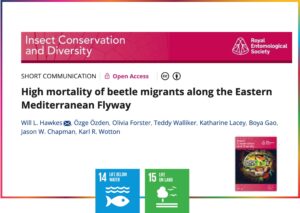
Researchers from Near East University have contributed to a study on migration-related mortality among insects, with a particular focus on beetles. The study, which examined the aftermath of a 100 km over-sea migration along the Eastern Mediterranean Flyway from the Middle East mainland to Cyprus, revealed fascinating insights into the challenges faced by insect migrants.
The findings, published in a scientific journal, indicate that the majority of strandline recordings consisted of two beetle species, the seven-spot ladybird (Coccinella septempunctata) and the carabid beetle (Calosoma olivieri). Notably, only nine individuals of C. septempunctata were successfully recorded arriving with the insect assemblage over the ocean. The study associated major strandings with easterly winds, suggesting origins from the Middle East mainland, with the documented insects appearing extremely weak, unable to fly, or deceased.
The research suggests that beetles, compared to other members of migratory insect assemblages, are weaker migrants, and the over-sea crossing poses a significant challenge for the majority, resulting in high mortality rates. The study delves into the potential impact of this mortality on marine ecosystems, emphasizing the need for further research to understand the ecological consequences.
Despite the challenges faced by beetles during migration, the study highlights their critical ecological roles, particularly as biocontrol agents. Ladybirds, such as C. septempunctata, are known to be effective aphid predators, contributing to pest control in agricultural crops. The carabid beetle C. olivieri also plays a crucial role as a generalist predator of caterpillars.
The research raises intriguing questions about the effects of high insect mortality during over-sea migratory flights on marine ecosystems. The study proposes that the stranded beetles, representing a small percentage of migrants, could contribute large quantities of nutrients to the sea, potentially impacting marine life.
This study, featuring contributions from researchers at Near East University, provides valuable insights into the dynamics of insect migration and its ecological implications. Ongoing monitoring programs at migration hotspots, like the tip of the Karpaz Peninsula in Cyprus, are crucial for understanding the patterns of stranded insects and their potential ecological contributions.
As researchers continue to explore migration-related mortality, the study underscores the need for comprehensive investigations into the movement capabilities of various taxa within migratory insect assemblages and the broader impacts on ecosystems.
More Information:
https://resjournals.onlinelibrary.wiley.com/doi/full/10.1111/icad.12673